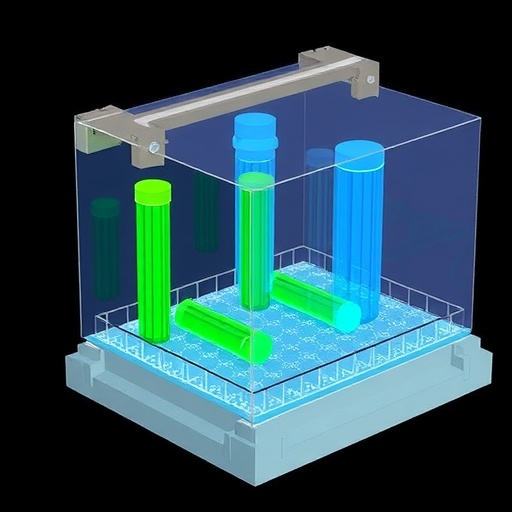In the realm of proton exchange membrane fuel cells (PEMFCs), optimizing gas transfer characteristics is paramount for enhancing performance and efficiency. A recent study by Tang et al. investigates the innovative design of gradient gas diffusion layers (GDLs) and their impact on the dynamics of gas transfer in PEMFCs. This research delves into the complex interplay between transport phenomena and the electrochemical processes occurring within fuel cells, presenting findings that could reshape the future of fuel cell technology.
The basic design of PEMFCs integrates multiple components that work symbiotically to convert chemical energy from hydrogen and oxygen into electrical energy. Central to this process is the gas diffusion layer, which serves as a conduit for reactant gases to reach the catalyst layers where the electrochemical reactions occur. Traditional GDLs have employed uniform properties, but the introduction of gradient designs can optimize gas transport and overall cell performance. This nuanced approach seeks to address some of the existing limitations in conventional designs.
Gas transfer dynamics in PEMFCs are influenced by various factors including porosity, permeability, and liquid water management within the GDL. This study emphasizes that gradient GDLs can facilitate enhanced gas diffusion by strategically varying these properties throughout the layer, which leads to improved reactant gas accessibility at the catalyst sites. Consequently, this optimization results in higher current densities and improved power output, which are vital parameters for any fuel cell performance assessment.
Moreover, the research contrasts the performance of traditional uniform GDLs with the innovative gradient counterparts, providing invaluable insights into their operational mechanisms. The authors utilized sophisticated modeling techniques to simulate gas flow, analyzing how gradients in pore size and thickness can significantly alter the pressure drop and resistance to gas flow. These experimental findings highlight the potential of gradient designs to substantially mitigate mass transport losses commonly associated with fuel cell operation.
Water management is another critical aspect, as liquid water accumulation can impair reactant access and overall cell performance. By manipulating the structure of the GDL, the authors demonstrate that gradient configurations can optimize liquid water distribution, thereby reducing flooding in certain areas while maintaining adequate hydration of the membrane. This strategy not only enhances efficiency but also extends the lifespan of the fuel cell by preventing damage caused by excessive water accumulation.
The experimental methodology employed in this study included various characterization techniques to comprehensively assess the gradient GDLs. Techniques such as scanning electron microscopy (SEM) enabled the researchers to visualize the microstructure of the GDLs, revealing how varying pore sizes and shapes contribute to improved gas transport properties. This meticulous analysis underscores the relationship between structure and function, offering a roadmap for future GDL designs.
The implications of this work extend far beyond theoretical considerations. With the global push toward sustainable energy solutions, the advancements in PEMFC technology could play a pivotal role in the transition to cleaner energy sources. The insights gained from this research could guide the development of more efficient fuel cells, ultimately contributing to the viability of hydrogen as a primary energy carrier in the future.
In light of the urgency to address climate change, technological innovations like those presented in this study are essential. The optimization of fuel cell systems aligns with broader goals to reduce fossil fuel reliance and enhance energy sustainability. By facilitating more effective hydrogen utilization through better GDL designs, these findings represent a step forward in achieving clean energy goals.
Another noteworthy contribution of this research is its potential influence on related applications beyond just PEMFCs. The principles of gradient design and gas transport optimization may extend to other fields, including batteries and supercapacitors, where efficient ion transport is equally crucial. This cross-pollination of ideas underscores the interconnected nature of contemporary energy technologies and the importance of interdisciplinary approaches.
In conclusion, Tang et al. deliver a compelling study that illustrates the crucial nature of gas transfer characteristics in proton exchange membrane fuel cells. By examining the advantages of gradient gas diffusion layers, the research not only enhances our understanding of the fundamental processes involved but also sets a foundation for future innovations in fuel cell technology. As we continue to explore the boundaries of clean energy, contributions like these are vital for paving the way towards a more sustainable future.
Thus, this research sheds light on the intricate dynamics of gas transport in fuel cells and demonstrates how strategic modifications in design can lead to substantial performance improvements. The merging of experimental evidence with theoretical modeling represents a significant step toward optimizing PEMFC systems and understanding the underlying mechanisms at play.
The ongoing investigation into gradient GDLs not only highlights the technical advancements in proton exchange membrane fuel cells but also serves as a call to action for researchers and engineers alike. Collaboration across disciplines and sectors will be key to realizing the full potential of fuel cell technology and its role in a cleaner, energy-efficient world.
In summary, this pioneering work reveals the critical nature of gas transfer dynamics in PEMFCs and champions the innovation of gradient gas diffusion layers as a pathway to unprecedented performance enhancements. As the urgency for cleaner energy solutions escalates, each step toward optimizing fuel cell technology is a step toward a more sustainable future.
Subject of Research: Gas transfer characteristics of gradient gas diffusion layers for proton exchange membrane fuel cells.
Article Title: Gas transfer characteristics of gradient gas diffusion layers for proton exchange membrane fuel cells.
Article References:
Tang, X., Yan, S., Shi, Y. et al. Gas transfer characteristics of gradient gas diffusion layers for proton exchange membrane fuel cells.
Ionics (2025). https://doi.org/10.1007/s11581-025-06745-9
Image Credits: AI Generated
DOI: https://doi.org/10.1007/s11581-025-06745-9
Keywords: Gradient gas diffusion layers, proton exchange membrane fuel cells, gas transfer, water management, sustainable energy.




